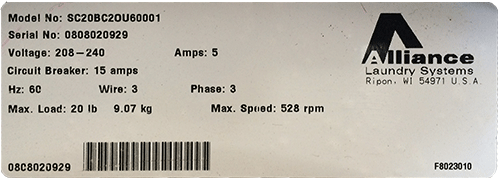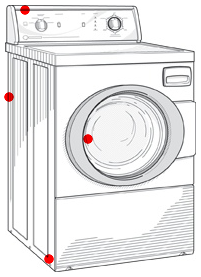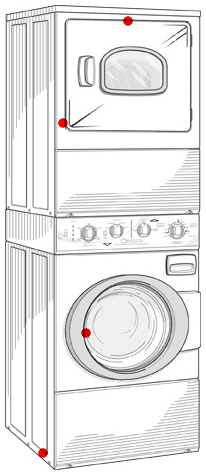- Home »
- Resources »
- Repair Help »
- Residential Washers »
- Washer Leaks Water
Washer Leaks Water
-
Troubleshooting
Video Tutorial
Troubleshooting
Note: The information here is general and may not be specific to your machine. If you need help with choosing the correct parts for your model, you can contact us using the tech support form here or calling our parts support team at 1-323-490-1805. If you leave a message, we'll get back to you within 24 hours.
Check that the fill hoses are properly installed on the faucets and to the washer's mixing valve.
Check that the fill hoses for damage and leaks
Fill hoses should be replaced every five years.
Check the drain hose for damage and leaks
Check the drain hose to make sure it is not clogged with debris or damaged.
Check the drain hose for clogs
Check the drain hose to make sure it is not clogged with debris.
Check that the drain receptacle is not clogged
Verify that the drain plumbing is working and free of clogs or debris.
Are you using too much detergent?
Using too much detergent can cause over-sudsing, which can cause splashing and overflow, leaving water and soap on the floor and looking like a leak. Be sure to use the proper amount of soap, according to the detergent packaging.
Is the machine overloaded?
Overloading the machine can also cause splashing and overflow, leaving wet floor that looks like a leak. Make sure you don't put too much clothes in the machine.
Hoses
Important: Unplug the washer from its power source before starting any inspection or repair work.
The hoses are the most common points of failure for a leaking machine. Washing machines employ multiple hoses, though the likely problems would come from the fill hoses or the drain hose.
The fill hoses go from the water source to the water inlet valve. These are in the rear of the machine. Pull the machine from the wall and check that these hoses are fine. The hoses should be kink-free and damage-free. If they are, next check the rubber washer inside. Disconnect the hoses and inspect. If the hose or washer is damaged, replace them.
If it's not the cold or hot fill hoses, check the drain hose next. This is connected to the drain pump, toward the front bottom of the machine. Remove the front panel and inspect the hose for a good connection and for cracks or perforation.
There are other internal hoses to inspect, such as the tub-to-drain hose. If any hose is damaged, do not try to repair and reuse it. Replacement is the recommended solution.
Drain Pump
A broken drain pump is another common cause of leaks. All water travels through this part, so if there's a hole or crack in it, it's going to allow water to leak. If there isn't visible problem with the pump, but it still leaks, it's likely the bearings. When a drain pump leaks, there is no repair solution. The only option is to replace it with another.
Water Seals
Washing machines rely on several seals. There is the tub seal, tub spin seal, and door seal. Each plays a part in keeping water from leaking anywhere. The seals are rubber and susceptible to rips, tears, and holes.
When a seal is damaged, the best route to take is replacement. Replacing a seal will require disassembly of the machine. Replacing the door seal is fairly easy, while the tub seal is more difficult.







